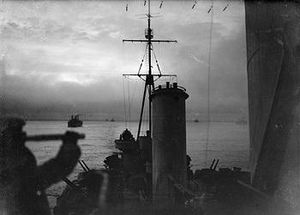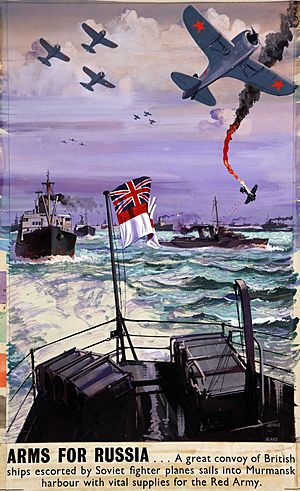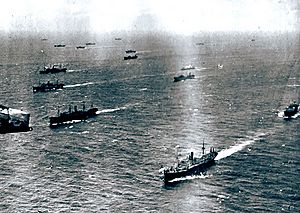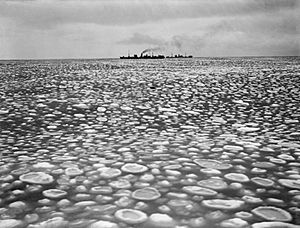Arctic convoys of World War II facts for kids
Quick facts for kids Arctic convoys of World War II |
|||||||
|---|---|---|---|---|---|---|---|
| Part of World War II | |||||||
 View from the cruiser HMS Sheffield as she sails on convoy duty through the waters of the Arctic Ocean. In the background are merchant ships of the convoy. |
|||||||
|
|||||||
| Belligerents | |||||||
| Casualties and losses | |||||||
| 85 merchant vessels 16 warships |
4 warships 30 submarines |
||||||
During World War II, the Arctic convoys were groups of ships that sailed together for safety. These convoys traveled from the United Kingdom, Iceland, and North America to northern ports in the Soviet Union. The main ports were Arkhangelsk and Murmansk in Russia.
Between August 1941 and May 1945, there were 78 convoys. They sailed through parts of the Atlantic Ocean and the Arctic Ocean. About 1,400 merchant ships carried vital supplies to the Soviet Union. These supplies were part of agreements like the Lend-Lease program.
Warships from the Royal Navy (UK), Royal Canadian Navy, and the U.S. Navy protected these merchant ships. The journeys were very dangerous. Eighty-five merchant ships and 16 Allied warships were lost. Nazi Germany's navy, the Kriegsmarine, lost several ships and many U-boats (submarines). These convoys showed that the Allied countries were committed to helping the Soviet Union. They also forced Germany to keep many of its naval and air forces in the Arctic.
Contents
Why Were Arctic Convoys Needed?
In June 1941, Germany launched a surprise attack on the Soviet Union. This attack was called Operation Barbarossa. The next month, Britain and the Soviet Union became allies. Britain quickly started sending tanks and aircraft to the USSR. This aid was meant to help their new ally stay in the war against the Axis powers.
The United States also helped through the Lend-Lease program. This program allowed the U.S. to provide war materials to its allies. The Soviet Union joined Britain and the U.S. as one of the "Big Three" Allies.
How Were Convoys Organized?

The first convoy, called "Dervish," sailed in August 1941. After that, the Arctic convoys ran in two main series:
- The first series, PQ (outbound to Russia) and QP (homebound from Russia), ran from September 1941 to September 1942.
- The second series, JW (outbound) and RA (homebound), ran from December 1942 until the end of the war.
The convoys usually started from Iceland or Scotland. They traveled north of Jan Mayen Island to Arkhangelsk or Murmansk. The route was very close to German-occupied Norway. This made the journeys extremely risky.
What Made the Arctic Route So Dangerous?
The Arctic route was one of the most challenging places to sail during the war.
- Enemy Forces: German planes, submarines (U-boats), and warships were always a threat.
- Harsh Weather: Severe storms, thick fog, and strong currents were common.
- Ice: Drift ice could damage ships or trap them.
- Sonar Problems: The mixing of cold and warm waters made it hard for ASDIC (underwater sound detection) to work well.
- Daylight Extremes: In winter, there was constant darkness, making navigation difficult. In summer, there was constant daylight, meaning ships could be attacked around the clock.
Important Convoys and Battles
- The "Dervish" Convoy (August 1941): This was the very first convoy. It had six merchant ships and arrived safely in Arkhangelsk.
- Convoy PQ 17 (July 1942): This convoy suffered the worst losses of any convoy in World War II. German forces attacked it, and the convoy was ordered to scatter. Only 11 out of 35 merchant ships made it through.
- Battle of the Barents Sea (December 1942): German warships, including the Admiral Hipper, tried to attack Convoy JW 51B. British destroyers and cruisers fought them off.
- Battle of the North Cape (December 1943): The German battleship Scharnhorst tried to attack Convoy JW 55B. British warships, including HMS Duke of York, intercepted and sank the Scharnhorst.
List of Arctic Convoys
1941 Convoys
| Outbound | Homebound | ||
|---|---|---|---|
| Dervish | departed Hvalfjörður, Iceland, August 21; arrived Arkhangelsk, Russia, August 31 |
||
| PQ 1 | departed Hvalfjörður September 29; arrived Arkhangelsk October 11 |
QP 1 | departed Arkhangelsk September 28; arrived Scapa Flow, Scotland, October 10 |
| PQ 2 | departed Liverpool, England, October 13; arrived Arkhangelsk October 30 |
||
| PQ 3 | departed Hvalfjörður November 9; arrived Arkhangelsk November 22 |
QP 2 | departed Arkhangelsk November 3; arrived Kirkwall, Scotland, November 17 |
| PQ 4 | departed Hvalfjörður November 17; arrived Arkhangelsk November 28 |
||
| PQ 5 | departed Hvalfjörður November 27; arrived Arkhangelsk December 13 |
QP 3 | departed Arkhangelsk November 27; dispersed, arrived December 3 |
| PQ 6 | departed Hvalfjörður December 8; arrived Murmansk, Russia, December 20 |
QP 6 | arrived Scapa Flow, Scotland, December 29 |
| PQ 7a | departed Hvalfjörður December 26; arrived Murmansk January 12, 1942 |
QP 4 | departed Arkhangelsk December 29; dispersed, arrived January 9 |
| PQ 7b | departed Hvalfjörður December 31; arrived Murmansk January 11 |
1942 Convoys
| Outbound | Homebound | ||
|---|---|---|---|
| PQ 8 | departed Hvalfjörður January 8; arrived Arkhangelsk January 17 |
QP 5 | departed Murmansk January 13; dispersed, arrived January 19 |
| Combined PQ 9 and PQ 10 | departed Reykjavík, Iceland February 1; arrived Murmansk February 10 |
QP 6 | departed Murmansk January 24; dispersed, arrived January 28 |
| PQ 11 | departed Loch Ewe, Scotland February 7; departed Kirkwall February 14; arrived Murmansk February 22 |
QP 7 | departed Murmansk February 12; dispersed, arrived February 15 |
| PQ 12 | departed Reykjavík March 1; arrived Murmansk March 12 |
QP 8 | departed Murmansk March 1; arrived Reykjavík March 11 |
| PQ 13 | departed Reykjavík March 20; arrived Murmansk March 31 |
QP 9 | departed Kola Inlet, Russia March 21; arrived Reykjavík April 3 |
| PQ 14 | departed Oban, Scotland March 26; arrived Murmansk April 19 |
QP 10 | departed Kola Inlet April 10; arrived Reykjavík April 21 |
| PQ 15 | departed Oban April 10; arrived Murmansk May 5 |
QP 11 | departed Murmansk April 28; arrived Reykjavík May 7 |
| PQ 16 | departed Reykjavík May 21; arrived Murmansk May 30 |
QP 12 | departed Kola Inlet May 21; arrived Reykjavík May 29 |
| PQ 17 | departed Reykjavik June 27; dispersed, arrived July 4 |
QP 13 | departed Arkhangelsk June 26; arrived Reykjavík July 7 |
| (August sailing postponed) | (August sailing postponed) | ||
| PQ 18 | departed Loch Ewe September 2; arrived Arkhangelsk September 21: first convoy with aircraft carrier escort (HMS Avenger) |
QP 14 | departed Arkhangelsk September 13; arrived Loch Ewe September 26 |
| (PQ cycle terminated ) | QP 15 | departed Kola Inlet November 17; arrived Loch Ewe November 30 |
|
| Operation FB | sailings by independent unescorted ships | (QP cycle terminated ) | |
| JW 51A | departed Liverpool December 15; arrived Kola Inlet December 25 |
||
| JW 51B | departed Liverpool December 22; arrived Kola Inlet January 4, 1943; see Battle of the Barents Sea |
RA 51 | departed Kola Inlet December 30; arrived Loch Ewe January 11 |
1943 Convoys
| Outbound | Homebound | ||
|---|---|---|---|
| JW 52 | departed Liverpool January 17; arrived Kola Inlet January 27 |
RA 52 | departed Kola Inlet January 29; arrived Loch Ewe February 9 |
| JW 53 | departed Liverpool February 15; arrived Kola Inlet February 27 |
RA 53 | departed Kola Inlet March 1; arrived Loch Ewe March 14 |
| (cycle postponed through summer) | (cycle postponed through summer) | ||
| JW 54A | departed Liverpool November 15; arrived Kola Inlet November 24 |
RA 54A | departed Kola Inlet November 1; arrived Loch Ewe November 14 |
| JW 54B | departed Liverpool November 22; arrived Arkhangelsk December 3 |
RA 54B | departed Arkhangelsk November 26; arrived Loch Ewe December 9 |
| JW 55A | departed Liverpool December 12; arrived Arkhangelsk December 22 |
RA 55A | departed Kola Inlet December 22; arrived Loch Ewe January 1, 1944 |
| JW 55B | departed Liverpool December 20; arrived Archangel December 30; see Battle of the North Cape |
RA 55B | departed Kola Inlet December 31; arrived Loch Ewe January 8 |
1944 Convoys
| Outbound | Homebound | ||
|---|---|---|---|
| JW 56A | departed Liverpool January 12; arrived Archangel January 28 |
||
| JW 56B | departed Liverpool January 22; arrived Kola Inlet February 1 |
RA 56 | departed Kola Inlet February 3; arrived Loch Ewe February 11 |
| JW 57 | departed Liverpool February 20; arrived Kola Inlet February 28 |
RA 57 | departed Kola Inlet March 2; arrived Loch Ewe March 10 |
| JW 58 | departed Liverpool March 27; arrived Kola Inlet April 4 |
RA 58 | departed Kola Inlet April 7; arrived Loch Ewe April 14 |
| (escorts only to Murmansk) | RA 59 | departed Kola Inlet April 28; arrived Loch Ewe May 6 |
|
| (cycle postponed through summer) | (cycle postponed through summer) | ||
| JW 59 | departed Liverpool August 15; arrived Kola Inlet August 25 |
RA 59A | departed Kola Inlet August 28; arrived Loch Ewe September 5 |
| JW 60 | departed Liverpool September 15; arrived Kola Inlet September 23 |
RA 60 | departed Kola Inlet September 28; arrived Loch Ewe October 5 |
| JW 61 | departed Liverpool October 20; arrived Kola Inlet October 28 |
RA 61 | departed Kola Inlet November 2; arrived Loch Ewe November 9 |
| JW 61A | departed Liverpool October 31; arrived Murmansk November 6 |
RA 61A | departed Kola Inlet November 11; arrived Loch Ewe November 17 |
| JW 62 | departed Loch Ewe November 29; arrived Kola Inlet December 7 |
RA 62 | departed Kola Inlet December 10; arrived Loch Ewe December 19 |
| JW 63 | departed Loch Ewe December 30; arrived Kola Inlet January 8, 1945 |
RA 63 | departed Kola Inlet January 11; arrived Loch Ewe January 21 |
1945 Convoys
| Outbound | Homebound | ||
|---|---|---|---|
| JW 64 | departed Clyde, Scotland February 3; arrived Kola Inlet February 15 |
RA 64 | departed Kola Inlet February 17; arrived Loch Ewe February 28 |
| JW 65 | departed Clyde March 11; arrived Kola Inlet March 21 |
RA 65 | departed Kola Inlet March 23; arrived Loch Ewe April 1 |
| JW 66 | departed Clyde April 16; arrived Kola Inlet April 25 |
RA 66 | departed Kola Inlet April 29; arrived Clyde May 8 |
| JW 67 | departed Clyde May 12; arrived Kola Inlet May 20 |
RA 67 | departed Kola Inlet May 23; arrived Clyde May 30 |
What Was the Purpose of the Convoys?
The convoys delivered important goods like tanks, fighter planes, fuel, ammunition, and food. These supplies were crucial for the Soviet Union. The Arctic convoys also had a big impact on the war. They forced Germany to send many of its powerful warships, like the battleship Tirpitz, to Norway.
The Tirpitz was a "fleet in being". This means it was a powerful warship that just by existing, tied up many British naval resources. These resources could have been used elsewhere. However, the Tirpitz spent most of the war hidden in Norwegian fjords. It was attacked many times and finally sunk by the Royal Air Force (RAF) in November 1944.
The convoys also showed the Soviet Union that the Allies were truly committed to helping them. This was important, especially before the Allies could open a second major land front in Europe.
How Did Intelligence Help?
British intelligence played a key role in the success of the convoys. They used Ultra signals intelligence, which came from breaking Germany's secret Enigma code. This allowed the British to read German messages.
By reading these messages, the British knew when German warships or U-boats were moving. This information helped the Royal Navy prepare for battles. It also allowed them to provide the right amount of escort ships for the convoys. For example, knowing about the Scharnhorst's movements helped HMS Duke of York sink it.
Stories from the Convoys
The difficult journeys of the Arctic convoys have been told in many books.
- HMS Ulysses (1955) by Scottish writer Alistair MacLean is a famous novel about naval warfare.
- The Captain (1967) by Dutch author Jan de Hartog also describes the challenges faced by sailors.
- The Russian novel Requiem for Convoy PQ-17 by Valentin Pikul shows the bravery of the sailors.
These books help us understand the extreme dangers and incredible endurance of the people involved.
Other Ways Supplies Reached the USSR
The Arctic route was the shortest way to send aid to the Soviet Union. However, it was also the most dangerous. About 3,964,000 tons of goods were sent this way, with 93 percent arriving safely. This was about 23 percent of all aid sent to the USSR during the war.
Other routes were also used:
- The Persian Corridor: This was the longest route, going through Iran. It carried 4,160,000 tons of goods, about 27 percent of the total aid.
- The Pacific Route: This route opened in August 1941. After Japan entered the war, only Soviet ships could use it. They carried non-military goods. This route moved 8,244,000 tons of goods, which was 50 percent of the total aid.
A part of the Pacific Route also went through the Bering Strait to the Soviet Arctic coast. Small Soviet convoys used this route, escorted by icebreakers. This route delivered 452,393 tons of goods.
See Also
- Rösselsprung ("Knight's Move") — German naval campaign to sink Arctic convoys
- Northwest Staging Route — Aviation supply route from North America to Siberia used by Allied forces
- Operation Wunderland
- List of merchant ships lost in Convoy PQ 17
- Arctic Ocean operations of World War II
- Arctic Star
- Don't Play the Fool... — A Russian comedy partly based on the life of a war veteran in Arctic convoys.
- HMS Ulysses (novel)
- The Captain (novel)





